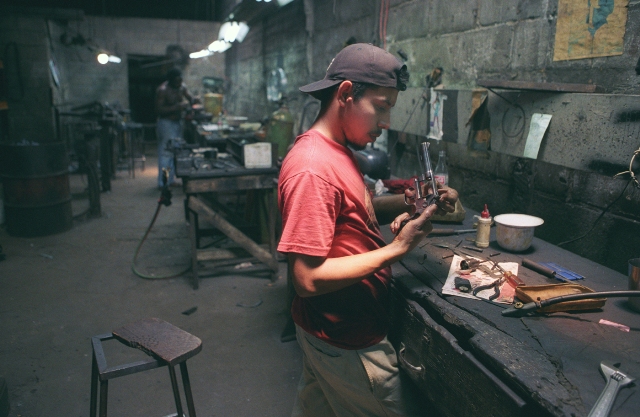Growing up is a world of violence in Honduras

Honduras is plagued by youth related violence and the situation is getting worse.
Today the overall homicide rate per 100 000 stands at 66.8 (Observatorio de la Violencia 2010). It is the second highest rate in a region that is known to be one of the most dangerous areas in the world.
Back in 2004 the homicide rate was 49% of all violent deaths. In 2009 the figure had already spiraled up to 65%.
Childhood and adolescence is cut short with thousands of young men and women being affected by violence each year as both victims and perpetrators. Children and youth are the ones caught in the middle, with abandoned youth most at risk.
Interpeace, an international peacebuilding organization, has been working in the region on this issue since 2007.
Isabel Aguilar, Director of the Central American Youth Programme, explains that violence against youth includes domestic and criminal violence, organized crime, arbitrary executions, violence in prisons and violence by the state. “It is physical and verbal. But it is also structural and cultural.” Isabel expands her explanation of the context: “Structural violence corresponds to the way society is organized. It can mean social exclusion, economic inequality, racism, sexism and other forms of discrimination.”
Isabel goes on to highlight that the causes of violence are attributed to a number of reasons: “Historical, political and social factors contribute to the situation we have in Honduras today. Poverty and unemployment is widespread. Violence is seen to be used to gain or keep power or benefit financially. Others are taking a different angle, claiming it is the expansion of organized crime, drug trafficking and arms dealing. Immigrants returning to Honduras from the United States, as well as gangs are also blamed.”
With many crimes going uninvestigated it is difficult to really know the causes. What is certain is the situation today is not sustainable and today’s context needs to be documented to truly understand the situation and then move forwards.
The first of two reports being launched today by Interpeace will do just this. 'A Violent World: Growing up in Honduras (PDF, Spanish)' is now available in Spanish. It analyzes the different forms of violence that are affecting Honduran teenagers and youth today. It also outlines the typical responses that have been taken so far.
Despite the fact that in Honduras 69% of the population is under 30 (INE,2008) and that adolescents are the most affected by youth and violence, little attention has been made to social policies for children and youth.
The second document that contains clear policy proposals for youth violence prevention is also being launched today in Tegucigalpa, Honduras.
'Locally and Nationally - Preventing Violence Affecting Youth in Honduras (PDF, Spanish)' outlines policy proposals that have come out of country-wide consultations. Primary prevention proposals cover domestic and family violence, violence in schools, violence in the community and by the state.
Secondary prevention strategies include comprehensive care for vulnerable youth as well as promoting the social reintegration of gang members. Tertiary prevention proposals promote educational measures for children and young offenders, as well as rehabilitation programmes.
Isabel closes by confirming what will be achieved by these two documents. “We need to promote a culture of peace so youth are no longer the ones that lose out. By reducing the overall risk factors and providing greater support and protection to those at risk we can work to further eleviate the problem. And then finally, a focus on tertiary prevention, working with offenders, a holistic and more sustainable approach to violence prevention will be possible.”
